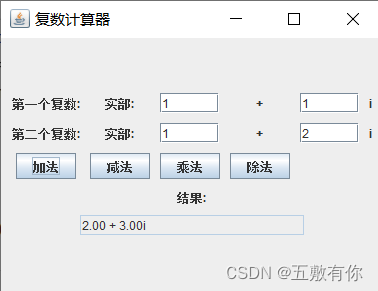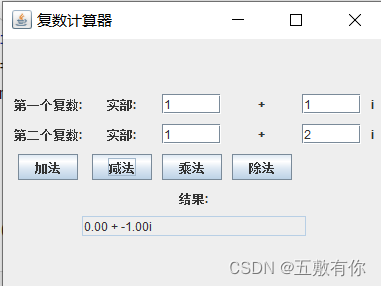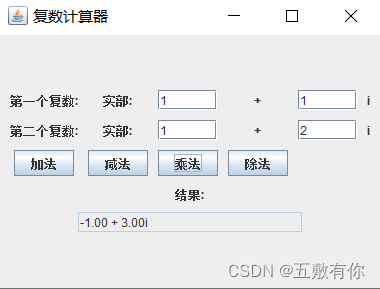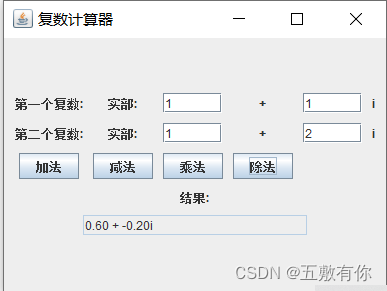实现复数计算器
复数计算器实现
摘要
????????本论文描述了一个复数计算器的设计和实现,旨在扩展传统计算器的功能,以支持复数的加法、减法、乘法和除法。通过使用Java编程语言和Swing图形用户界面库,我们创建了一个直观、易于使用的界面,允许用户输入复数,并执行基本的算术运算。
引言
????????计算器作为一种广泛应用的数学工具,一直以来都在满足人们基本计算需求的同时,逐渐演化为更为复杂和功能强大的设备。然而,在传统计算器中,对于复数的处理相对受限,这在某些应用场景中可能会引起困扰。复数在数学和科学计算中具有重要意义,因此,设计一个能够高效处理复数运算的计算器,不仅可以丰富计算器的功能,也能够更好地满足用户需求。
????????本论文旨在介绍和探讨一个新型复数计算器的设计和实现。该计算器的目标是通过扩展传统计算器的功能,使其具备对复数的全面支持,包括加法、减法、乘法和除法等基本运算。我们选择使用Java编程语言,并借助Swing图形用户界面库,以实现直观、用户友好的界面,允许用户在计算过程中轻松地处理复数
一、设计目标和要求
????????为了实现一个全面支持复数运算的计算器,我们制定了以下设计目标和要求,以确保设计的功能性、实用性和用户友好性:
支持基本运算: 计算器应能够执行基本的加法、减法、乘法和除法运算。这包括对正数和复数的运算。
复数输入和显示: 用户应能够输入复数,并在计算器界面上正确显示复数。此外,计算结果中应正确包括复号。
用户界面友好: 设计直观、简洁的图形用户界面,使用户能够轻松输入数值和进行操作。提供清晰的标签和按钮,以便用户理解和使用各种功能。
输入验证: 对用户输入进行有效性验证,确保输入的数值合理且不会导致不稳定的计算结果。给予用户有关输入错误的明确反馈。
鲁棒性: 通过合理的错误处理和异常处理机制,提高计算器的鲁棒性,确保在各种输入条件下都能稳定运行。
用户提示和帮助: 在用户界面中提供提示信息和帮助文档,使用户能够更好地理解计算器的功能和使用方法。
测试用例覆盖: 设计和执行全面的测试用例,覆盖正数、复数、各种运算符和输入条件,以确保计算器在各种情况下都能正确工作。
性能优化: 通过合理的算法和数据结构选择,优化计算器的性能,确保在处理大型数值或复杂计算时仍能保持响应速度。
扩展性: 考虑未来的扩展性,使计算器能够轻松地集成更多高级数学运算或功能,以满足不断变化的用户需求。
二、系统架构和设计
为了实现一个全面支持复数数运算的计算器,我们采用了模块化和清晰的系统架构。整体设计分为以下几个关键模块:
用户界面模块: 该模块复责处理与用户的交互。我们使用了Swing图形用户界面库,创建了一个直观、简洁的用户界面,包括文本框用于输入实部和虚部、操作按钮用于选择不同的运算,以及显示区域用于展示计算结果。
输入验证模块: 在用户输入实部和虚部时,这个模块负责验证输入的有效性,包括检查是否为合法数字、是否包含正确的负号位置等。合理的错误提示将直接反馈给用户。
复数计算模块: 这是计算器的核心模块,负责实现复数的加法、减法、乘法和除法运算。我们设计了一个名为
ComplexNumber的类,用于表示和处理复数,包括复数。该类包含了对复数进行各种运算的方法。结果显示模块: 该模块负责将计算得到的结果正确地显示在用户界面上。在显示时,我们要确保对于复数的显示是准确的。
下面是系统的一些关键设计决策:
面向对象设计: 我们采用了面向对象的设计原则,通过创建
ComplexNumber类来抽象和封装复数的概念,从而更好地支持复数的运算。这有助于代码的可维护性和扩展性。用户友好的界面设计: 在用户界面上,我们使用了清晰的标签和按钮,以及良好的布局,使用户能够轻松理解和使用计算器。错误提示和帮助信息的及时反馈也增加了用户友好性。
输入验证和异常处理: 我们在设计中加入了输入验证模块,确保用户输入的数值是合法的,从而防止无效输入导致的计算错误。异常处理机制被用于处理运算过程中可能发生的异常情况。
测试驱动开发(TDD): 我们采用了测试驱动开发的方法,通过编写测试用例来驱动程序的设计和实现。这有助于确保每个模块的功能都能够正确执行,并在整个开发过程中提高代码的质量。
整体而言,系统的设计追求清晰简洁、模块化,以确保易于理解、维护和扩展。系统架构和设计的决策旨在实现一个高效、稳定、易用的复数计算器。
三、功能和特点
我们的复数计算器旨在提供丰富的功能和用户友好的特点,以满足用户在处理复数时的各种需求。以下是该计算器的主要功能和特点:
基本运算支持: 支持复数的加法、减法、乘法和除法运算。用户可以轻松执行这些基本的复数运算。
复数输入: 用户可以输入包含实部和虚部的复数,包括负数、零以及正数。输入框提供了良好的交互性,允许用户直观地输入复数。
用户界面友好: 通过使用Swing图形用户界面库,设计直观、简洁的用户界面。清晰的标签、按钮和布局使用户能够轻松理解和使用计算器。
结果显示: 结果显示区域以易读的形式展示复数的实部和虚部,确保用户可以清晰地了解计算结果。
错误处理: 引入了输入验证和异常处理机制,确保用户输入的合法性,并对可能的错误情况提供明确的错误提示,以增强计算器的鲁棒性。
操作提示和帮助: 用户界面提供了操作提示和帮助文档,帮助用户更好地理解和使用计算器。这些提示可以在用户犯错时提供帮助,并提高用户体验。
测试覆盖: 通过测试用例确保了计算器在各种情况下的正确性。测试用例覆盖了正数、负数、零以及各种复数运算,以验证计算器的稳定性和正确性。
四、实现和测试
界面的布局设计
package test;
import javax.swing.*;
import java.awt.*;
import java.awt.event.ActionEvent;
import java.awt.event.ActionListener;
public class ComplexCalculatorGUI extends JFrame {
private JTextField real1Field, imaginary1Field, real2Field, imaginary2Field, resultField;
public ComplexCalculatorGUI() {
setTitle("复数计算器");
setSize(400, 300);
setDefaultCloseOperation(JFrame.EXIT_ON_CLOSE);
setLocationRelativeTo(null);
// 创建界面组件
real1Field = new JTextField(5);
imaginary1Field = new JTextField(5);
real2Field = new JTextField(5);
imaginary2Field = new JTextField(5);
JButton addButton = new JButton("加法");
JButton subtractButton = new JButton("减法");
JButton multiplyButton = new JButton("乘法");
JButton divideButton = new JButton("除法");
resultField = new JTextField(20);
resultField.setEditable(false);
// 创建面板并设置布局
JPanel panel = new JPanel(new GridBagLayout());
GridBagConstraints constraints = new GridBagConstraints();
constraints.insets = new Insets(5, 5, 5, 5);
// 第一行
constraints.gridx = 0;
constraints.gridy = 0;
panel.add(new JLabel("第一个复数:"), constraints);
constraints.gridx = 1;
panel.add(new JLabel("实部:"), constraints);
constraints.gridx = 2;
panel.add(real1Field, constraints);
constraints.gridx = 3;
panel.add(new JLabel("+"), constraints);
constraints.gridx = 4;
panel.add(imaginary1Field, constraints);
constraints.gridx = 5;
panel.add(new JLabel("i"), constraints);
// 第二行
constraints.gridx = 0;
constraints.gridy = 1;
panel.add(new JLabel("第二个复数:"), constraints);
constraints.gridx = 1;
panel.add(new JLabel("实部:"), constraints);
constraints.gridx = 2;
panel.add(real2Field, constraints);
constraints.gridx = 3;
panel.add(new JLabel("+"), constraints);
constraints.gridx = 4;
panel.add(imaginary2Field, constraints);
constraints.gridx = 5;
panel.add(new JLabel("i"), constraints);
// 第三行
constraints.gridx = 0;
constraints.gridy = 2;
panel.add(addButton, constraints);
constraints.gridx = 1;
panel.add(subtractButton, constraints);
constraints.gridx = 2;
panel.add(multiplyButton, constraints);
constraints.gridx = 3;
panel.add(divideButton, constraints);
// 第四行
constraints.gridx = 0;
constraints.gridy = 3;
constraints.gridwidth = 6;
panel.add(new JLabel("结果:"), constraints);
// 第五行
constraints.gridy = 4;
panel.add(resultField, constraints);
// 添加事件监听器
addButton.addActionListener(new OperationListener("add"));
subtractButton.addActionListener(new OperationListener("subtract"));
multiplyButton.addActionListener(new OperationListener("multiply"));
divideButton.addActionListener(new OperationListener("divide"));
// 将面板添加到窗口
add(panel);
// 设置窗口可见
setVisible(true);
}
private class OperationListener implements ActionListener {
private String operation;
public OperationListener(String operation) {
this.operation = operation;
}
@Override
public void actionPerformed(ActionEvent e) {
performOperation(operation);
}
}
private void performOperation(String operation) {
try {
double real1 = Double.parseDouble(real1Field.getText());
double imaginary1 = Double.parseDouble(imaginary1Field.getText());
double real2 = Double.parseDouble(real2Field.getText());
double imaginary2 = Double.parseDouble(imaginary2Field.getText());
ComplexNumber num1 = new ComplexNumber(real1, imaginary1);
ComplexNumber num2 = new ComplexNumber(real2, imaginary2);
ComplexNumber result = null;
switch (operation) {
case "add":
result = num1.add(num2);
break;
case "subtract":
result = num1.subtract(num2);
break;
case "multiply":
result = num1.multiply(num2);
break;
case "divide":
result = num1.divide(num2);
break;
}
resultField.setText(result.toString());
} catch (NumberFormatException ex) {
resultField.setText("输入无效");
}
}
public static void main(String[] args) {
SwingUtilities.invokeLater(() -> new ComplexCalculatorGUI());
}
}
复数类的计算
package test;
public class ComplexNumber {
private double real;
private double imaginary;
public ComplexNumber(double real, double imaginary) {
this.real = real;
this.imaginary = imaginary;
}
public ComplexNumber add(ComplexNumber other) {
return new ComplexNumber(this.real + other.real, this.imaginary + other.imaginary);
}
public ComplexNumber subtract(ComplexNumber other) {
return new ComplexNumber(this.real - other.real, this.imaginary - other.imaginary);
}
public ComplexNumber multiply(ComplexNumber other) {
double newReal = this.real * other.real - this.imaginary * other.imaginary;
double newImaginary = this.real * other.imaginary + this.imaginary * other.real;
return new ComplexNumber(newReal, newImaginary);
}
public ComplexNumber divide(ComplexNumber other) {
double denominator = other.real * other.real + other.imaginary * other.imaginary;
double newReal = (this.real * other.real + this.imaginary * other.imaginary) / denominator;
double newImaginary = (this.imaginary * other.real - this.real * other.imaginary) / denominator;
return new ComplexNumber(newReal, newImaginary);
}
@Override
public String toString() {
return String.format("%.2f + %.2fi", real, imaginary);
}
}
五、运行结果和讨论




六、结论
????????在本次复数计算器的设计与实现中,我们着眼于为用户提供一个强大而易用的工具,使复数运算变得简单而直观。在明确了设计目标与要求的基础上,我们采用了面向对象的设计思想,将系统划分为用户界面、输入验证、负数计算以及结果显示等模块,以实现模块化的系统架构。通过使用Java Swing,我们成功创建了一个直观、简洁的用户界面,从而提高了用户的整体体验。
本文来自互联网用户投稿,该文观点仅代表作者本人,不代表本站立场。本站仅提供信息存储空间服务,不拥有所有权,不承担相关法律责任。 如若内容造成侵权/违法违规/事实不符,请联系我的编程经验分享网邮箱:chenni525@qq.com进行投诉反馈,一经查实,立即删除!